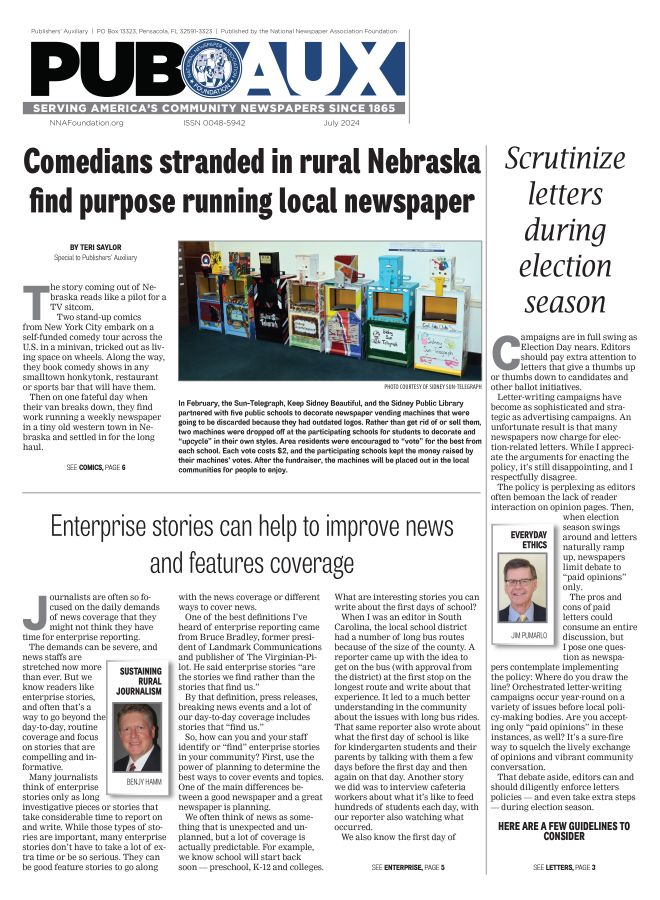Postal frequently asked questions
Why is the Postal Service changing the way it deals with newspapers and others?
Postal Service is changing the way it deals with all mailers. The loss of First-class mail to the Internet is a primary driver, leading it to seek new economies of scale and greater automation opportunities.
Automation usually does not play to the advantage of newspapers; on the other hand, the Postal Service's high labor costs doesn't make the alternative much more attractive. At the same time, high fuel costs are driving more community papers into the mail service. In short, USPS is facing a lot of the same external forces as are newspaper publishers.
FSS, IMB, DDU — How does one make sense out of this alphabet soup?
Postal Service has a workforce of about 700,000 people to manage, and virtually every business in America to serve. Ever-dynamic productivity initiatives, marketing developments and other changes mean organizing masses of people. Projects need names and names soon become initials. It can be dizzying. But FSS stands for Flats Sequencing System, the new automation program to automate sorting of the carrier's mail in walk-sequence order instead of manual casing in the post offices; IMB for Intelligent Mail Barcode, which is intended to put more information into addressing barcodes, and track service if desired; and DDU is Destination Delivery Unit, the designation usually meaning local post offices for our newspaper members — the place where they usually enter their mail, and where carriers now sort the mail for delivery on their routes.
What is Intelligent Mail Barcoding?
It comes in two flavors. The basic IMB is intended to more precisely define the address of a mail piece. The Full Service Barcode is optional, but will allow each piece of mail to have a unique identifying number so the piece can be tracked through the system, pretty much the way packages are tracked now. You could go online to see where your newspaper is as it flows through mail facilities. This latter may be a nice-to-have option, but is likely to be too expensive and of little practical use to newspapers.
Will papers be forced to use the IMB system? What happens if I don't use the system? Will the Postal Service refuse my mail or just hit me with higher rates?
If you don't use it, you won't receive automation discounts after May 20ll, under present deadlines.
Do papers need to use an IMB just for its mailed periodicals, or will this also affect other mass mailings such as the monthly bills or checks?
It will affect flats mail — that is mail larger than an envelope, and smaller than a package. So a periodical, a shopper or a TMC product would be affected. But it only affects presorted mail other than carrier-route, at least in the near future. That would be 5-digit, 3-digit, SCF, ADC, OMX, MADC sorted mail which is the only mail eligible for automation discounts
My paper already prints a bar code on the front of my newspaper. Is this the same thing as an IMB? Am I going to need to make room for another bar code on the front if I mail a lot of copies?
The postal barcode, the so-called PostNet bar code, can be used until May 2011, and then would have to be replaced by the basic IMB, if automation rates are desirable. But this barcode should not be confused with the retail sales barcode that may be required to sell single copies. Two different purposes: two barcodes. It goes as part of the address label, in place of the present POSTNET.
Will every single mailed piece need an IMB, or can one apply to whole trays of mail?
IMBs will be needed on each piece, each bundle and each container (such as a tray), if newspapers decide to use them.
What kind of technology changes will a paper need to make in order to comply with new rules? Will papers need to subscribe to any type of service and what might that cost?
They can join NNA, and get all the postal counseling they want for free. They should also have good postal software, like that advertised in the pages of Pub Aux.
If I take my bundles to the post office in sacks now, will I be able to continue doing that, or will I need to change my operation?
Now is a good time to give up the sacks altogether. Most newspapers have found a better way: use flats tubs for mail going outside your DDU. For DDU entered mail, just bring in the bundles.
In a recent survey of NCPA members, several already report traveling in excess of 50 miles from the press to a postal facility that will take their product. Should more newspapers expect to travel greater distances as postal operations change?
Possibly, but NNA is fighting to preserve DDU entry at the in-county office of origin under FSS.
How serious are discussions of a five-day-a-week delivery schedule?
Probably not very. Yet.
What is the timetable for new requirements by the Postal Service? Is there any wiggle room in the dates?
Which ones? NNA has already secured a two year delay for newspapers using the IMB. If you're talking about FSS changes, resolution of that issue is still on our plates. FSS is coming for sure, but the effect on newspapers is unresolved.
With all these changes, what should papers expect to happen on future postal rate increases?
Postmaster General Jack Potter has as recently as last week said he is committed to keeping increases within the current price-cap rate of inflation. But USPS lost nearly over $2 billion in the most recently ended fiscal year. Clearly, something has to give. How will it affect individual mail products? No one knows yet.
How do I find out if my newspaper will be affected by these changes or when?
Talk to your postmaster. Be involved in the Postal Customer Council if there is one. Read Max Heath's column in Publishers' Auxiliary.
When should a newspaper publisher start to panic?
Yesterday. Seriously, the Postal Service is caught up now in the general economic malaise. If that hasn't already pulled the pin on the panic grenade, you are probably living in a nice island somewhere sipping drinks with little umbrellas. More change is coming. The best advice is to remain flexible and pay attention.







